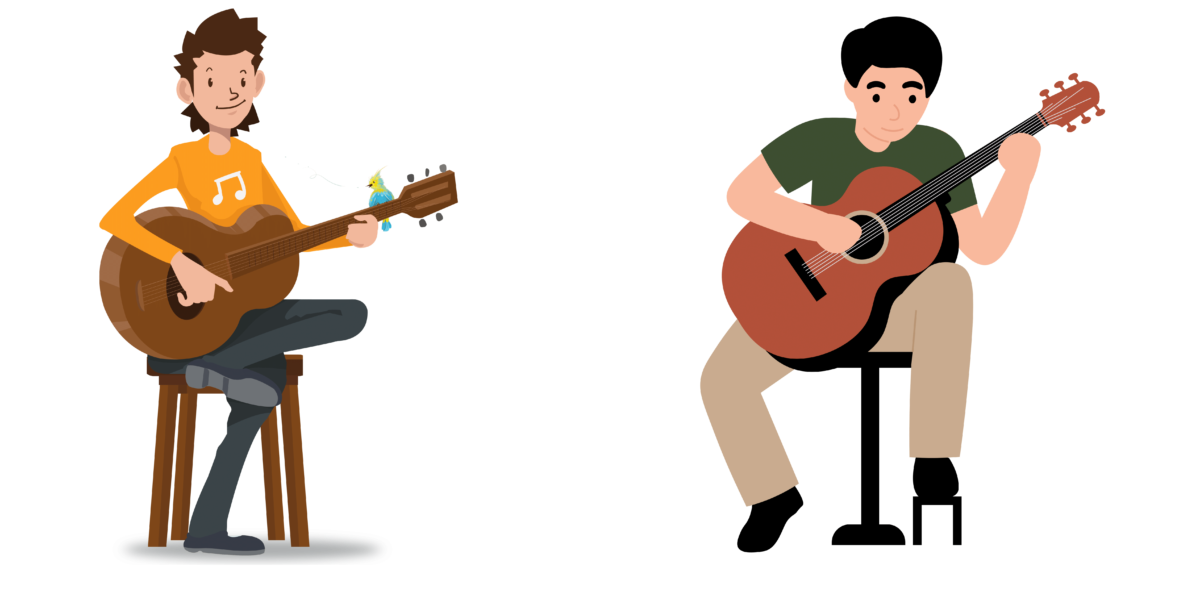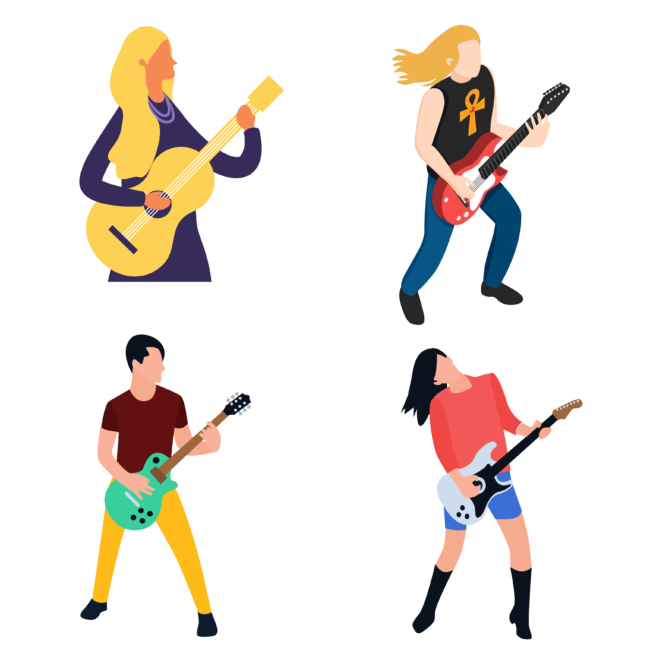How to Hold a Guitar Properly: The Definitive Guide

In this article, we will teach you how to hold a guitar in the right way and what are the common mistakes beginners make when they hold a guitar for the first time.
When you sit down to play guitar, you concentrate on hitting the right notes and finding the correct strum pattern. However, the techniques you need to achieve a guitar masterpiece start as soon as you pick up the instrument.
Some guitarists stand up to play, while others sit down. Either way, once you learn how to hold your guitar, you are one step closer to making music like the pros.
Why posture matters.
When you start learning to play the guitar, posture may be the last thing on your mind. However, when you use correct techniques from the beginning, you have a solid foundation to build on as you advance.
Most guitarists focus on the fingerwork, but how you position your back, shoulders, feet, and arms. When your body is cramped, enjoying your practice time is hard. Your playing usually reflects your feelings. When you feel uncomfortable, the songs may sound stiff and stilted.
The correct guitar position may seem a bit awkward at first. However, your back, arms, and legs will thank you later. You can prevent injuries and make your guitar sing when you hold your guitar correctly.
Casual vs. classical positioning.
If you move from an acoustic guitar to a classical one, you may notice that the playing style is very different. The fretboard size is different, the type of strings is different, and you hold the guitar differently. Let’s take a closer look at the casual and classical guitar positions.
Casual position
Many electric and acoustic guitar players choose the casual position. This position has fewer guidelines than the classical position. Here are some tips for holding the guitar in the casual position:
- Keep your back straight.
- Tuck the guitar under your elbow. (But don’t hug the guitar.)
- If sitting, you can rest the guitar on your dominant side. So, if you are right-handed, rest the guitar on your right leg.
- Hold the body of the guitar in a slightly horizontal position.
- Keep your feet flat on the floor.
- The thumb often reaches over the fretboard for fingerstyle guitar playing.
Classical position
For the classical position, standing is not an option. There are also strict guidelines for how you should sit. Here are some tips for holding a guitar in a classical position:
- Keep your back straight and sit on the edge of the chair.
- Relax your shoulders and keep them straight.
- Use a footstool or guitar foot support to raise your left foot.
- Rest the guitar body on your left leg (if you are right-handed).
- The guitar head should be level with your head.
- Hold the neck of the guitar at a 45-degree angle.
- The thumb never reaches over the fretboard.

Once you decide on a casual or classical position, study the correct posture, then put the tips into practice.
Common mistakes beginners make while holding a guitar
When you learn how to hold a guitar, check your posture before you play. The “right way” to position a guitar can vary depending on if you choose the classical or acoustic style. However, some ways to hold a guitar are wrong for either position.
Here are some beginning guitarist mistakes to avoid:
Slumping over the guitar.
As a beginning guitarist, you may tend to slouch over the guitar to see where your fingers are landing. Instead of leaning toward your guitar, pull your guitar closer to your body. This tip helps you keep your back straight and makes your practice sessions more comfortable.
Standing up to play before you’re ready.
Most expert guitarists recommend starting your guitar journey in a sitting position to get more control over the guitar. Also, a correct sitting guitar posture is easier for many to master. For a classical guitar, you never need to stand up!
Adjusting a guitar strap too low or too high.
Most guitarists use guitar straps only when standing. However, some beginners feel more secure with a strap, even sitting. Adjust the strap to the right length so the guitar is at waist level.
Choosing an uncomfortable chair.
When you start to play, you want to choose a chair conducive to guitar playing. Find a chair without arms that allows you to keep both feet on the floor. Your knee bend should make a right angle when you sit down. If you choose a classical position, you can use a guitar footrest or even a stack of books to keep your leg elevated. Playing the guitar on a sofa (although comfortable) can create bad posture habits.
How to hold a guitar: sitting position.
As we saw above, the sitting postures for the classical and casual styles are very different. But, in either position, your goal is to keep your muscles comfortable and relaxed. Many guitarists use a footstool to raise one leg and rest the guitar on it. This puts your guitar in a comfortable, secure position without needing a guitar strap.

How to hold a guitar:
standing position.
When you play the guitar standing up, the guitar should hang near your hips. Some rock stars play their guitars super low or super high. However, these extreme positions can put a strain on your muscles. While it may look cool to hold a guitar differently, it may also shorten your career when your muscles start to ache.
You don’t want your guitar to be up in your armpit or around your knees when you stand up. To find that sweet spot that isn’t too high or too low, adjust the guitar strap while you are in the sitting posture. Then, when you stand up, the guitar should be in the perfect position for you to show off your skills.
Right-hand vs. Left-hand positions
In Piano Hand Placement each hand is responsible for hitting the keys. However, when you play the guitar, your right and left hands have very different jobs.
The left hand is preparing the notes on the fretboard. Then, the right hand is responsible for picking or strumming the strings to make the music. You can already guess that the proper posture for each hand also differs greatly.
Let’s see how to position the right and left hands.
Right-hand position on the guitar
Rest your right arm on the guitar body. You want your forearm close to the elbow to make contact with the guitar body. This relaxes your arm to get ready to play the guitar.
Half of your hand should cover the sound hole. Then, the tips of your fingers are ready to strum the strings. Don’t bend the wrist when you play the guitar strings in an up-and-down motion, d. Instead, allow your forearm to move the hand. This technique eliminates wrist strain and lets your play the guitar fluidly.
Left-hand position on the guitar
On the left hand, you want to keep the wrist relatively straight. Similar to Piano Hands, you want to curve the fingers. This position keeps you from hitting other strings and gives you a clear sound. The fingers should press the guitar strings near the fret toward the sound hole (not in the middle of the fret).
The placement of the thumb is vital. Keep the thumb perpendicular to the guitar neck instead of in line. This position reduces strain on your thumb and keeps your guitar stable. Generally, you want your thumb to line up with the pointer finger on the opposite side of the neck.
As you play the guitar, your left-hand position may change as you stretch to reach chords. However, the above position should be your “home base.”
Check your posture, then start playing the guitar.
Playing the guitar can be a rewarding journey. This instrument is portable to pack up and transport to jam with your friends. Or you can go busking and play for an audience.
For a long career in the guitar field, you want to start with good habits. Before you learn to play diatonic scales on the guitar, you should know how to hold your guitar properly. Once you have the right position down, you are ready to rock out on the guitar.









